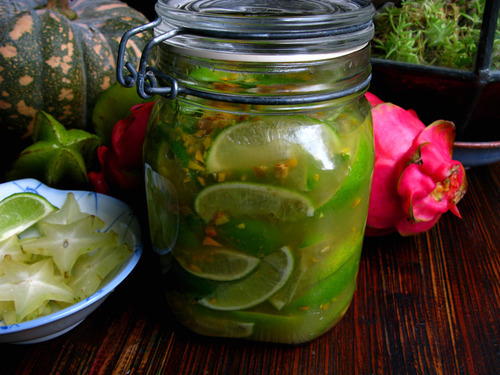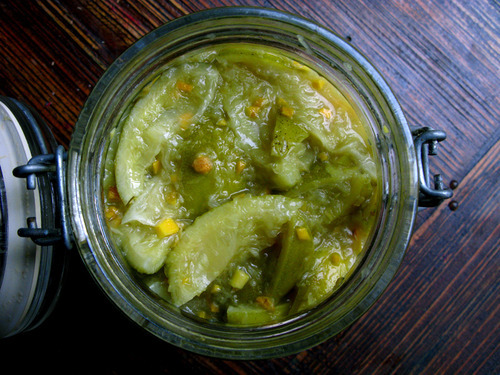Indian Lime Pickle

One of the benefits of the community ethic is that produce can be shared. This increases the available diversity of foods, and is environmentally sound. Today I swapped a few things with our neighbours, who have a very prolific lime tree. In exchange for some milk, some kefir fermented milk, some turmeric and a little ginger I was gifted a nice pumpkin, some lovely dragon and star fruit, and a big bag of limes. Time to make some Indian lime pickle methinks. I am starting with the long fermented pickle first, and will make other shorter ferments using different tastes when more limes come on line. So without further ado, here is the long fermented lime pickle.
We will need …
1 kg of organic limes
3 tbsp Himalayan crystal, pure sea, or other quality salt
1 tbsp mango vinegar (substitute any other vinegar)
¼ cup finely diced fresh turmeric root, skin on (loosely packed)
1 cup coconut oil or ghee
¼ cup mustard seed
¼ cup fenugreek seed
1 tbsp fennel seed
2 tbsp cayenne pepper
1 tbsp asafoetida powder
6 black pepper corns, roughly crushed
6 or so hot chillies, diced, seeds in or out to taste
6 or so curry leaves (substitute 2 or 3 bay leaves)
3 cloves of true garlic, finely diced
What do we do with that stuff?
- Wipe the limes with a damp cloth, then cut into 8 wedges each
- Place in a bowl and add the salt, massaging the salt into the limes
- Add the vinegar and turmeric, massage again
- Place the mix into a suitable sized glass vessel (about 1 litre capacity minimum) with a lid that can be sealed. Pack the limes down hard, brine will be expressed, and when all are tightly packed, pour in the brine and any diced turmeric remaining in the bowl.
- Seal the jar and place somewhere it can be seen daily, because it will need a shake or stir every day (or few days at least)
- This needs to lacto-ferment for four weeks, by which time the peels will be nicely softened, and the mix will be full of beneficial probiotic organisms, amino acids, enzymes, electrolytes and vitamins
And then what?
- In a small pan dry fry the seeds until the fenugreek has changed colour and mustard seeds are just thinking about popping
- Let the seeds cool, then crush them briefly using a mortar and pestle
- Heat the oil or ghee in the same pan to a moderate heat, then add the seeds, the asafoetida, the crushed pepper, and the cayenne pepper. Stir frequently until the aroma of the spices have been well released. Asafoetida is aptly named, if you are unfamiliar with it don’t worry, it’s supposed to smell that way
- Add the diced chillies, stir briefly, then add the curry leaves (or bay leaves), again, stirring briefly.
- Turn the heat down low, add the garlic, and cook until the garlic is pale brown
- Allow the mixture to cool, remove the bay leaves if used, then pour into the jar of limes and shake or stir the contents well
- Let the jar sit out for two weeks of further fermentation to set the flavours, shaking the jar every few days. After this, store it in the refrigerator for a year or more.
So, six weeks, start to finish, but the end result will be worth it.
I will ramble on about turmeric now, if I may. Turmeric is a real medicinal super food, and has been used in Indian and Chinese medicine for thousands of years. Science has finally caught up with what traditional healers have known all along, and more of the multiple health benefits of turmeric continue to be experimentally shown. The main active ingredient in turmeric is curcumin, a fat soluble compound that has been shown to be beneficial for: mediating the inflammatory response within the body, and so having knock on benefits for auto-immune conditions and immune system functionality; increasing the anti-oxidant capacity within the body by not only being a powerful antioxidant itself, but by also enhancing and increasing the activity of the body’s own antioxidant enzymes; delaying or even reversing age and trauma related decreases in brain function, including Alzheimer’s (by increasing levels of Brain-Derived Neurotrophic Factor, a kind neural growth hormone in the brain); reversing many steps in the progression of heart disease via multiple routes/effects; cancer prevention and treatment, by inhibiting angiogenesis and metastasis, and by inducing cancer cell mortality; reducing and combating depression as effectively as major anti-depressant medications; improving indigestion, and assisting in weight loss; fighting colds, flu and other infections; and the list goes on seemingly forever. Traditional medicine claims over 800 beneficial effects for turmeric, so it is most likely a spice we would to use.
As with any herbal medicine, turmeric must be organic to be fully effective. Fresh root with the skin on is best, just wash off the soil, dry and store. Root or powder must be cooked with fat to release the full benefits of turmeric, and consumption of turmeric with black pepper increases the body’s ability to absorb curcumin by 2000% according to one study. So turmeric is best fried lightly in oil or ghee or animal fat before addition to a dish. The only exception here is fermentation, which increase bio-availability of curcumin in much the same way as combination with fats does.
In the recipe above, the high quality fats coconut oil or ghee are added to the already fermented turmeric, so all bases are covered. Let’s all enjoy these delicious lime pickles, and enjoy discovering ways of bringing the healing power of plant medicine into our lives.
Pickle update 1 - 4th May

Previously, in Indian Lime Pickle: the limes were salted, pulling juice from the segments, turmeric and a little home made vinegar was added.
The result was a fairly liquid brine that as you can see, after 4 days has begun the transformation to a thick condiment. The flesh of the limes and the pectin drawn from the skins have combined with the limey brine, and we can see the beginnings of nice, gelatinous Indian-style pickle.